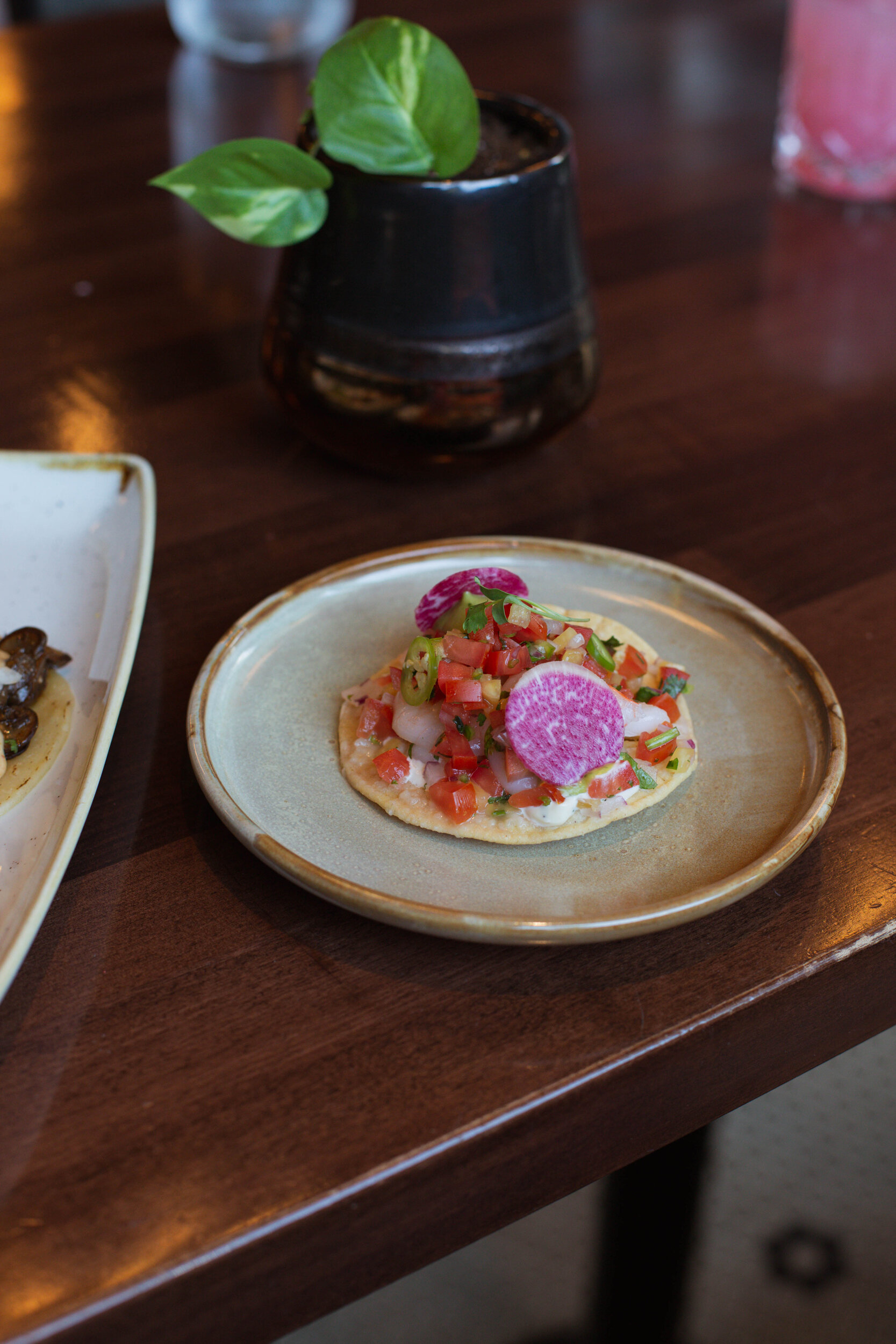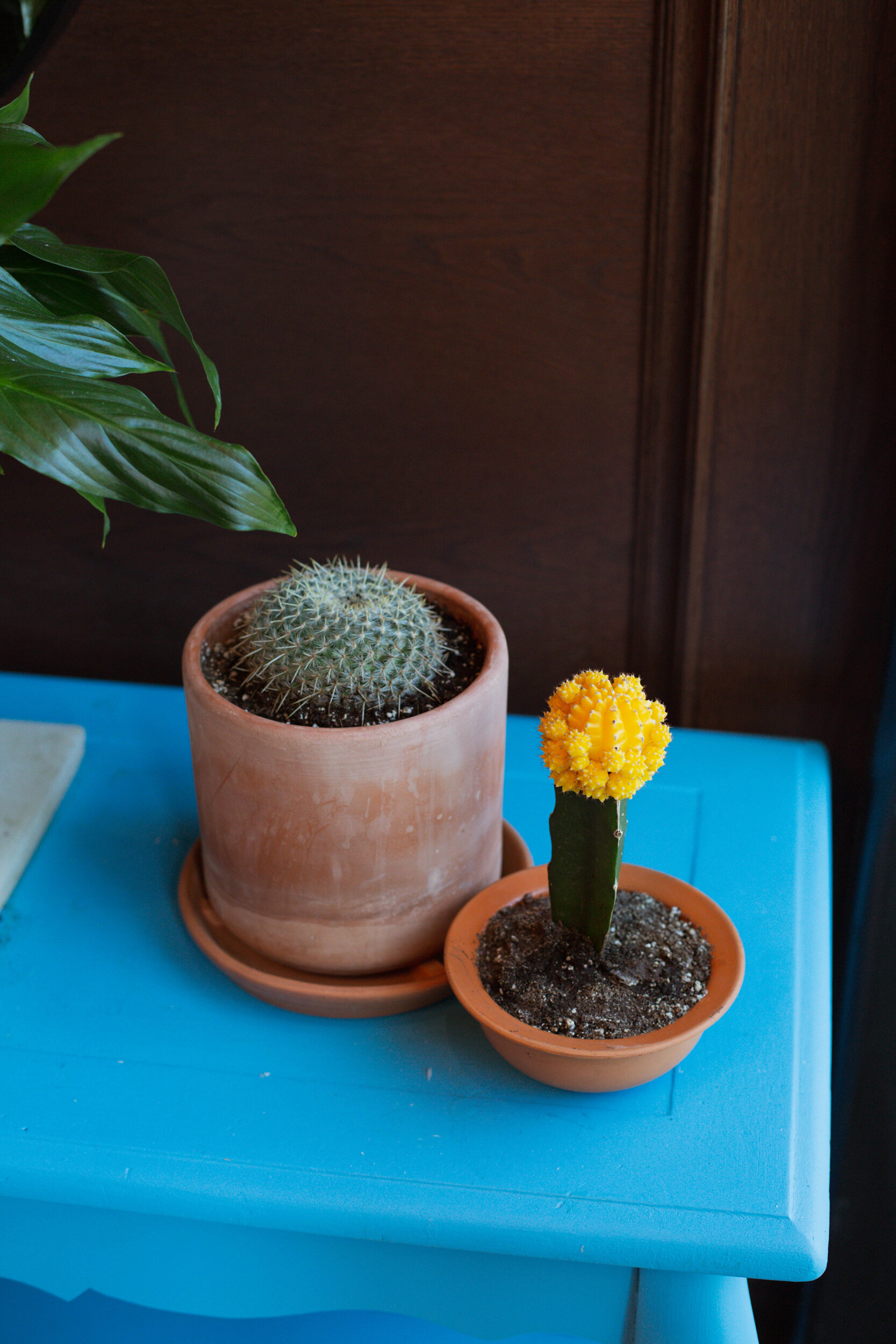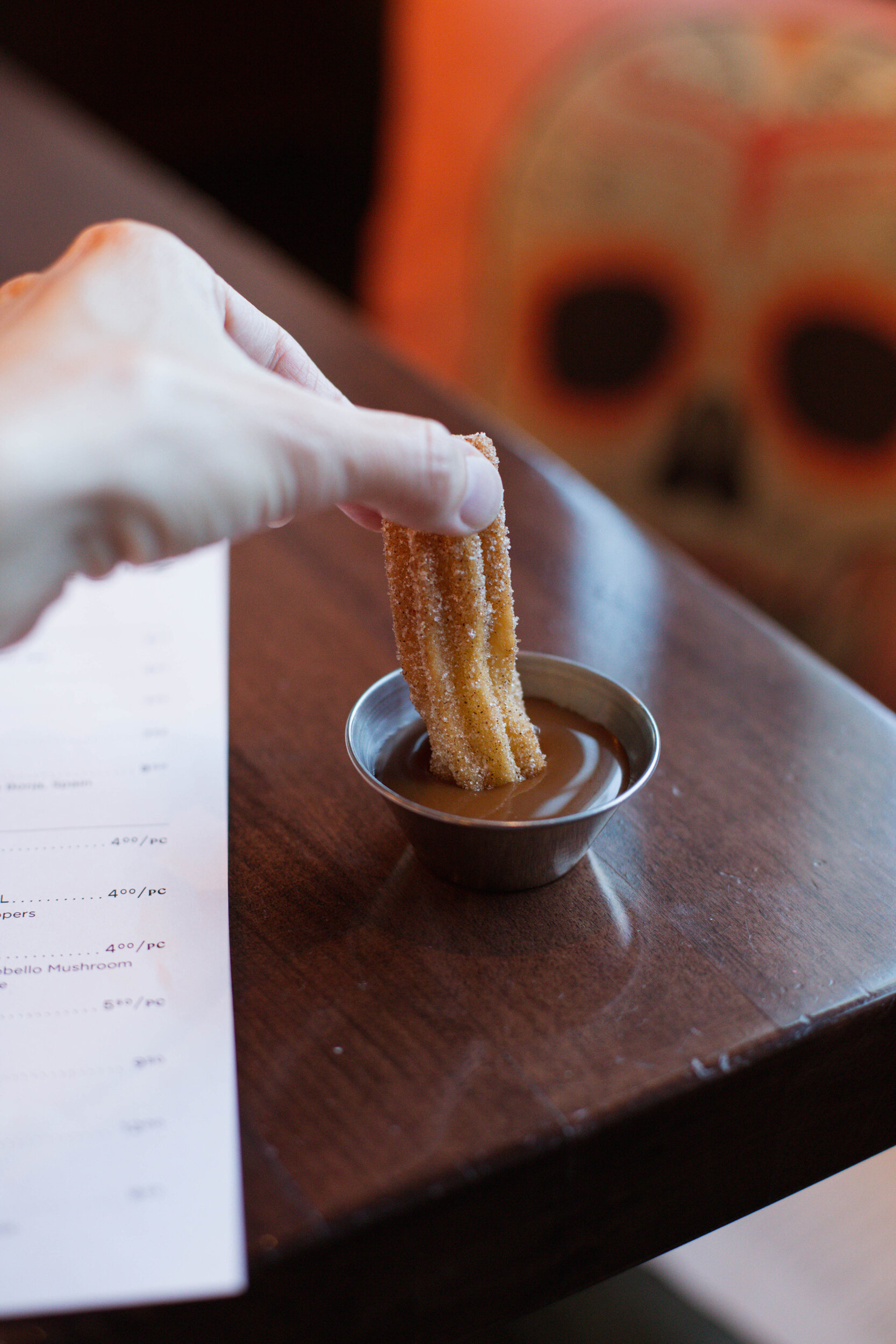OPHELÍA
OPHELÍA
AUTHENTIC GASTRONOMÍA DE MÉXICO LANDS IN VANCOUVER
Though they don’t open until 4:00 pm for dinner service, Chef Francisco Higareda goes into his new restaurant Ophelía Cocina Méxicana at 9:00 am every day. Once there, he makes sauces (salsa, molé, guacamole), checks the produce as it arrives, and awaits the delivery of his seafood—much of which, like the red snapper, is caught the day before. From the bar, Tim Cole—Ophelia’s Beverage Manager—will bring Higareda concoctions to taste. The two work closely together to incorporate traditional Mexican flavours into the restaurant’s cocktails. Cole is from Australia with a strong spirits background, which pairs wonderfully with Higareda’s wealth of knowledge on traditional syrups and spices.
Having only opened two weeks ago, the restaurant is already a hit. I went in for my first visit last week on Taco Tuesday—something Higareda laughs off as a bit too gringo a concept, but one that North Americans enjoy enough for him to acquiesce to. Every corner of the 5,000 sq. ft. restaurant—including the shaded side of the otherwise sun-drenched, L-shaped patio—was packed; Margaritas, tequila flights, or fresh tacos were spread across every table.
Pineapple Tiger Prawn Ceviche tostada with habanero crema.
Colourful interior touches by Higareda and his mother Ophelia.
Taco Tuesday aside, Ophelia is authentically Mexican—something Higareda wanted to return to. The Veracruz-born chef has worked all over the globe: He honed avant-garde techniques as a sous chef at Michelin-stared restaurants in Spain and France, saw the explosion of TexMex while working as a chef in Al Paso, and grew a distaste for monoculture agriculture systems in Peru and Argentina—a time when herbicide and chemical company Monsanto (now Bayer) expanded its monopoly on the growth of genetically-engineered corn. “I hate Monsanto,” he says with a grin. Higareda even took a three-year hiatus from cooking to play professional basketball in Mexico. (When the team sold him to a city he didn’t like, he returned to the kitchen to further explore his love for food.)
Hand-painted alebrijesare, Chef Higareda brought in from Oaxaca.
Ophelia mural by visual artist César Alegría, known as Saicker.
The Ophelia Margarita with Cuervo Tradicional and Hibiscus.
While Higareda appreciates fine dining—and will still incorporate French techniques into his current menus (he commonly uses both the soufflé and sous vide)—the seasoned chef was excited about returning to his family traditions. “I think Mexican cuisine is incredible,” Higareda tells me on a hot July afternoon inside Ophelia’s dark mahogany dining room. “It’s so big and changes so much state-by-state.” At 19, Higareda studied at Mexico City’s Ambrosia Culinary Centre, which he says instilled in him a pride of Mexican cuisine. He also comes from a cooking family: His mother, who was born in Spain but resides in Veracruz, in the Gulf of Mexico, cooks in a more “proper” fashion, Higareda tells me, while his father, who was born in a city near Guadalajara, is more “heavy”—he uses a ton of fat, salt, and spice in his cooking.
Roasted Bone Marrow with Chanco Tortillas made with biodiverse-focused, Zaachila-based company Id-Bi Maices corn.
Interiors by CDC Construction.
The main concept Higareda focuses on at his Vancouver restaurant is known in Spanish as cuisine a la memorial—“The cuisine in your conscious, or your memories,” he explains. “Pretty much all these flavours that you try here, are flavours I tried at some point in my life.” Tradition, to him, is very important. The molé blanco which comes with the octopus is a recipe from his home state and the aguachile is a recipe from the North of Mexico. “I have dishes that my mom used to make (the Pollo En Molé De La Casa) and then I have others that I’ve put my own twist on. The Rib Eye Aguachile is a little bit different, or I’ll throw a bit of sesame oil on something that didn’t call for it.” Another technique from Higareda’s illustrious background that can be easily appreciated is his talent—gleaned from years in Michelin-starred kitchens—for the art of plating. “I play with how the dish looks—make it a bit nicer,” he says humbly.
Santa Muerte Sour with Montelobos Mezcal, Squid Ink Tincture, and Lemon Agave.
Sun-drenched, south-facing patio.
Entering the room for the first time after the remodel (the room used to house seafood spot WildTale) I was happy to see the beautiful former interior wasn’t entirely gutted. The team kept the stunning millwork—recessed wood wall paneling and mosaic floor tiles accented by polished brass—but added decorative Mexican folk-art to the interior. Higareda recruited his friend César Alegría, a visual and tattoo artist from Mexico, to paint two large murals: one, a Día de los Muertos-styled face on the south wall of the dining room and a heart mural that spans a back wall near the kitchen. His mother Ophelia (whom the restaurant is named after), helped with the design by sending the Lucha Libre masks while Higareda sourced brightly-coloured, hand-painted Alebrijesare from Oaxaca, a state on the Pacific side of Mexico.
Higareda’s chocolate caramel flan with tequila dulce de leche.
Churro with more tequila dulce de leche, perfect for dipping.
Ophelia is a partnership from the team who own Flying Pig and WildTale (which still has a location in Yaletown). Through a scout, proprietors John Crook and Erik Heck contacted Higareda a few years after he opened his second restaurant in Chihuahua, Mexico, where he was also teaching cooking classes at a university. He was ready to move on and liked what the Vancouver-based team stood for—and being Partner at a beloved establishment in one of North America’s most stunning cities was something only a fool would pass up.
Chef Francisco Higareda.
Moras Y Mezcal with Koch Espadin, créme de cassis, blackberries, lime, and egg white.
On my second visit to Ophelia, I had to try Higareda’s Pollo En Molé, inspired by his mother's cooking. A traditional molé, Higareda explained, is much like creating a sourdough starter—you have to feed it. He says it took him days of adding salt, spices, and cacao to get perfect. Once it’s ready, it serves as the base for one half of an organic chicken from Two Rivers, a silky tomato creamed rice, and sautéed green beans. I rarely order a dish I can make at home—and rice, chicken, and beans would certainly fit that category. But this one, paired with his molé and cooked to juicy perfection was worth bending my rule. The sun on the Southwest facing patio was hotter than any we had all spring, so a cold, Montelobos mezcal cocktail with squid ink tincture and lemon agave was a refreshing reprieve.
Chef Higareda speaking with guests on the large outdoor patio.
Outdoor patio along 2nd Avenue sits in the summer sun late into the evening.
Pollo En Molé De La Casa: roasted half chicken, creamed tomato rice, sautéed green beans, and Higareda’s house molé.
The team sources their meat and produce locally and works with local Ocean Wise seafood providers—7 Seas, Two Rivers, and Gelderman Farms to name a few of his regular suppliers. Higareda is familiar with the larger food suppliers such as Gordon Food Service and Sysco, but knows those companies don’t carry the best quality. We had a discussion about monoculture agricultural systems and the future of food. While his 16 oz rib-eye steaks from Cache Creek Ranch are far more expensive than what you can source from a factory-farm, he feels the result is worth it. A system that supports farmers producing pasture-raised beef is one he wants for our future; A passion for sustainable sourcing runs deep in Higareda's philosophy. Worthy of mention: The same steak at other fine-dining establishments can cost diners up to $90, but he sets theirs at $50. “I prefer to soak that cost up because I want people to try it,” he tells me.
Taco De Cochinita Pibil with marinated onions on corn tortilla; Vegan taco with guajillo portobello mushrooms.
Ophelia’s colourful outdoor patio settings.
Even the corn is sourced with respect for traditional ethno-ecology—a hard feat in our globalized, industrial farming systems. (Corn is notoriously difficult and resource-sucking to grow, so farmers who take on heirloom varietals are doing so principally out of passion). While creating the menu, the team tested tortillas from two different sources side-by-side for taste. One set was a frozen batch from Sysco, and another from Chanco Tortilleria. The taste was incomparable. “Their corn comes from Oaxaca,” Higareda tells me. “It’s different corn all the time: we can have red corn, or white, or black. Depends on the batch.” One of the owners from Chanco, who sources his corn from the biodiverse-focused, Zaachila-based Id-Bi Maices, comes into Ophelia to make batches daily. “He cooks the corn in here and makes the tortilla here, so every day we have fresh tortilla.” You can absolutely taste the difference.
The vibrant eatery is an overdue addition to the strip of establishments along 2nd Avenue, on the border of Olympic Village. The restaurant's menu stands above its dining counterparts; service, led by General Manager David Sandoval Castillo, is welcoming, warm, and unmistakably proud to serve what comes from the kitchen. During these extraordinarily difficult times for the food and beverage industry, it’s heartwarming to see such passion for cuisine and thoughtful sourcing persist.
Now the ball is in our court to support those putting in the work to create a future for food security—but it’s a tasty feat if you’re willing to take it on.
• Words & photography by Tracy Giesz-Ramsay


























